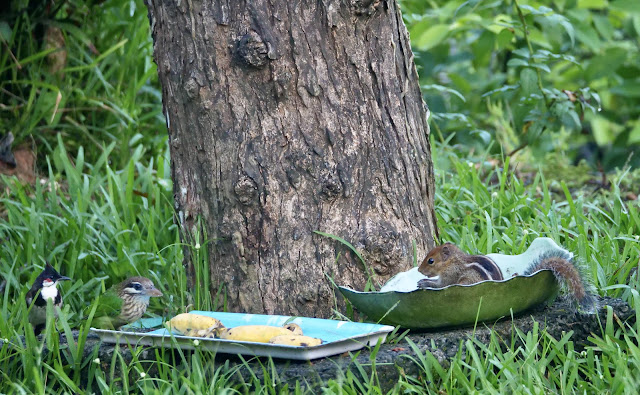The squirrel above waits at the opening of a tree cavity in the stem of this tree before it enters into it. I noticed it a few times that I inspected the hollow with light to see if it was rearing a litter of kittens. The red or grey squirrels make their drey in the fork of trees with leaves and hay or find a cavity for their nesting.
As squirrels are intelligent and protect themselves from predators, I was not surprised by this squirrel waiting at the mouth of the cavity till it was sure that no bird was around before it went into the cavity. I shall be on the look out if it is finally a nest for its breeding.
I have often noticed a squirrel co-feed with birds in the feeding station in our garden, which again is not usual. This is one way of adapting to meet its need. One habit of the squirrel is to hide its feed for use during the season of hibernation. I noticed this squirrel going up the tree with a large chunk of banana into its drey. The squirrels are known to hide food in multiple places to avoid being stolen by predators. They because of their sense of smell and spatial memory recover most of the food hidden.
The way they jump distances between branches of tree is a worthwhile acrobatic sight. They glide between branches sometimes, although some people think of it as flying. The flying squirrels live in north American forests.
One interest I followed over the years is to listen to their chirps which are varied in tone, pitch and loudness. They have special chirps during the time of mating which is a repeated sonorous chirp which make even a human pause to listen because of its musical quality. The squirrels being alert about predators, warn other squirrels with a particular loud chirp. I notice squirrels making loud chirps while moving from one tree to another. The squirrels are weary of rat snakes which sometimes hide in the overgrown grass in the garden. They avoid moving in the grass and use trees to travel from one place to another.
I remember Professor Jacob John, retired professor of clinical virology once mentioning that if a garden is friendly enough to birds and squirrels they will increase the plant and tree population by the bird droppings and the nuts the squirrels hide in the soil, which they fail to retrieve. In fact it was this approach which was used while attempting to convert the Bagayam campus of the Christian Medical College into a wooded space between buildings about hundred years ago.
There is a controversy among the environmentalists as to whether it is good to feed the squirrels. The argument against feeding is stronger as natural foraging, which is their instinct, is what we ought to encourage.
I look out for squirrels in the garden as I find their alert look and acrobatics interesting to observe.
During the season of Rambutan, the squirrels are larger in number in our garden. They feed on guava, papaya, mango and banana. Often they find the ripe fruits earlier than we can spot them.
The conservationist argue to have wooded spaces in residential areas if possible, because birds and squirrels thrive in such an eco system.
I come across a therapeutic approach used by public health specialists to create bird watching galleries in the cities for people to come and experience de-stressing by bird watching. On some days when I track the squirrel or bird movements, I would have walked across the garden couple of times, which sometimes is 1.5 kilometres according to the record in the phone I carry.
Living is an art of discovering more about what surrounds us in our environment!
M.C.Mathew(text and photo)




No comments:
Post a Comment